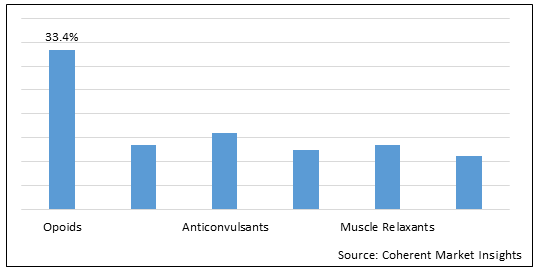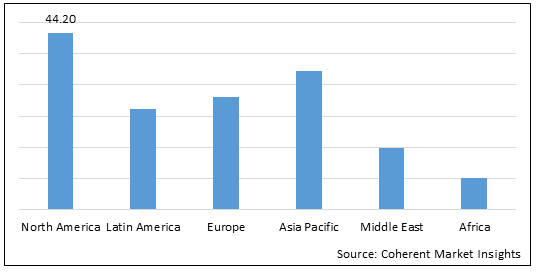Pain management drugs are prescribed in serious to mild pain conditions such as back pain, neck pain, and pain from cancer. Pain management drugs market is highly lucrative due to low availability of alternative drug therapies for treatment of pain. Drug manufacturers are introducing effective generic versions of pain management drugs in various dosage forms, which is driving market growth. Chronic pain is one of the highly prevalent pain disorders, which is primarily treated by these medications. The medical management of pain diseases is patient specific and is highly dependent on individual patients’ symptoms.
The global pain management drugs market is estimated to be valued at US$ 76,415.7 million in 2022 and is expected to exhibit a CAGR of 4.1% during the forecast period (2022-2030).
Figure 1. Global Pain Management Drugs Market Share (%), by Drug Class, 2022

To learn more about this report, Download Free Sample
Increasing government initiatives for research and development on pain management drugs is expected to drive the market growth over the forecast period
Increasing government initiatives such as funding by government organizations for research and development on pain management drugs is expected to drive the global pain management drugs market. For instance, in May 2022, Anticonvulsant Drug Development (ADD) Program was launched by National Institute of Neurological Disorders and Stroke (NINDS) to actively involved in the early identification and characterization of novel investigational anticonvulsant drugs for the symptomatic treatment of epilepsy. The centerpiece for the department's epilepsy-related research is The Anticonvulsant Drug Development (ADD) program. The primary purpose of this program is to identify potential new antiepileptic agents and the work is funded by a long-term National Institute of Health (NIH) research contract for the early evaluation of anticonvulsant drugs. The project uses preclinical seizure models and neuroscience techniques to help develop new antiepileptic agents. Some 800-1000 novel compounds per year are evaluated against conventional drugs for anticonvulsant efficacy and potency, neurotoxicity, effect on liver function, and mechanism of action.
Pain Management Drugs Market Report Coverage
| Report Coverage | Details | ||
|---|---|---|---|
| Base Year: | 2021 | Market Size in 2022: | US$ 76,415.7 Mn |
| Historical Data for: | 2017 to 2020 | Forecast Period: | 2022 to 2030 |
| Forecast Period 2022 to 2030 CAGR: | 4.1% | 2030 Value Projection: | US$ 105,252.1 Mn |
| Geographies covered: |
|
||
| Segments covered: |
|
||
| Companies covered: |
Pfizer, Inc., Sanofi S.A., Mylan N.V., Teva Pharmaceutical Industries Ltd., Eli Lilly and Company, Abbott Laboratories, Purdue Pharma L.P., GlaxoSmithKline Plc, Johnson & Johnson, and F. Hoffmann La Roche Ltd. |
||
| Growth Drivers: |
|
||
| Restraints & Challenges: |
|
||
Uncover macros and micros vetted on 75+ parameters: Get instant access to report
Figure 2.Global Pain Management Drugs Market Share (%), by Region, 2022

To learn more about this report, Download Free Sample
High prevalence of chronic pain diseases is expected to drive growth of the pain management drugs market over the forecast period.
Increasing prevalence of chronic pain diseases is expected to drive growth of the pain management drugs market over the forecast period. For instance, in February 2022, according to data published by National Center for Biotechnology Information, the Centers for Disease Control and Prevention (CDC) used data from the 2019 National Health Interview Survey (NHIS) to estimate that 50.2 million U.S. adults experienced chronic pain. A second CDC publication from National Health Interview Survey (NHIS) found that 22.1% of these U.S. adults with chronic pain used prescription opioids.
Moreover, in February 2022, according to data published by National Health Interview Survey (NHIS), the prevalence of chronic pain was 20.4% globally, and the prevalence of high-impact chronic pain was 7.4% (or 36.4% of adults who had chronic pain). Chronic pain was highest among women (21.7%), non-Hispanic white adults (23.6%), and those aged 65 and over (30.8%) overall globally.
Global Pain Management Drugs Market– Impact of Coronavirus (COVID-19) Pandemic
Since the COVID-19 virus outbreak in December 2019, the disease has spread to over 100 countries across the globe and the World Health Organization had declared it a public health emergency on January 30, 2020.
COVID-19 can affect the economy in three main ways: by directly affecting production and demand of drugs, by creating disruptions in distribution channels, and through its financial impact on firms and financial markets. Due to nationwide lockdowns, several countries, such as China, India, Saudi Arabia, U.A.E., Egypt, and others, are facing problems with regard to transportation of drugs from one place to another.
However, the COVID-19 pandemic had a positive impact on the global pain management drugs market, owing to possible association of pain management drugs with Covid-19. For instance, in July 2020, according to data published by National Center for Biotechnology Information, physical pain can be an early symptom of COVID-19 infection, as patients can complain about low back pain, widespread myalgias, or headache. Other pain syndromes can manifest during the infection, caused by the involvement of cranial nerves or nervous roots like Guillen Barre syndromes. Increasing evidence has demonstrated that SARS-CoV-2 has the ability to invade the nervous system above all in immunocompromised patients. According to recent studies by center for disease control, SARS-CoV-2 infection can cause many neurological diseases including viral encephalitis, meningoencephalitis, ischemic stroke, and hemorrhagic stroke. Hence, the need for pain management drugs increased which has been found to propel the global pain management drugs market growth.
Global Pain Management Drugs Market: Key Developments
In April 2022, Eli Lilly and Company, a pharmaceutical company, Eli Lilly and Company's clinical development pipeline passed phase II trial for LY3556050, a small molecule Somatostatin receptor type 4 (SSTR4 agonist). LY3556050, is designed to modulate somatostatin signaling, impacting nerve excitability, resulting in improved regulation of inflammation and pain. It is being developed for treatment of pain. Somatostatin receptor type 4 is a protein encoded by the SSTR4 gene.
In April 2022, Eli Lilly and Company, a pharmaceutical company, passed phase II trial for LY3526318, an oral, highly selective, small molecule antagonist of transient receptor potential ankyrin 1 (TRPA1). LY3526318 is a calcium-permeable nonselective cation channel expressed in pain sensing peripheral nerves. It is being developed as a non-opioid treatment for chronic pain conditions.
Global Pain Management Drugs Market: Restraint
The major factors that hinder growth of the global pain management drugs market include side effects associated with the pain management drugs and addiction issues with the opioid medications. For instance, in January 2022, according to National Institute on Drug Abuse, an opioid overdose can be reversed with the drug naloxone when administered. Improvements have been seen in some regions of the U.S. in the form of decreasing availability of prescription opioid pain relievers and decreasing misuse among the countries teenagers. However, since 2017, overdose deaths involving heroin increased dramatically.
Key Players
Major players operating in the global pain management drugs market include Pfizer, Inc., Sanofi S.A., Mylan N.V., Teva Pharmaceutical Industries Ltd., Eli Lilly and Company, Abbott Laboratories, Purdue Pharma L.P., GlaxoSmithKline Plc, Johnson & Johnson, and F. Hoffmann La Roche Ltd.
Share
Share
Missing comfort of reading report in your local language? Find your preferred language :
Transform your Strategy with Exclusive Trending Reports :
Frequently Asked Questions
Select a License Type
Joining thousands of companies around the world committed to making the Excellent Business Solutions.
View All Our Clients